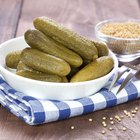
Ciaran Griffin/Stockbyte/Getty Images
Necessity was truly the mother of invention in the innovation of processed foods. While food preservation methods greatly enhance your ability to eat what you want when you want it, they also remove soluble fiber and other natural nutrients from raw foods and add ingredients that are, potentially, harmful to your health and well-being.
Legal Definition
The United States Federal Food, Drug and Cosmetic Act, Section 201, Chapter II defines processed food as "any food other than a raw agricultural commodity and includes any raw agricultural commodity that has been subject to processing, such as canning, cooking, freezing, dehydration, or milling." This definition establishes parameters for the Food and Drug Administration to regulate quality and safety in the food processing industry.
Food Processing History
Around 500,000 BC Neanderthals discovered fire and noticed that cooked and smoked meat lasted longer than raw meat. French chef Nicolas Apert canned foods in the early 1800s. The United States patented the process in 1815 and began mass-producing tin cans in 1847. In 1861, Louis Pasteur discovered that heating foods before sealing them destroyed harmful microorganisms; this was the process became known as "pasteurization." Freeze-drying techniques were used in the early 1900s in France, followed by the 1920 invention of a deep-freezing method by an American, Clarence Birdseye. The mass production of foods through modern processing methods evolved from industrialization, which led to factories and refined machinery, and breakthrough scientific discoveries in biotechnology. Mass transportation and the invention of refrigeration made it possible to deliver processed foods across continents.
Benefits
Disease reduction is an important benefit of food processing. As raw food begins to rot or spoil, it becomes contaminated by molds and bacteria that may cause you to get sick. Processing methods destroy those harmful pathogens. Processing foods also makes it possible for manufacturers to provide consumers with a greater variety of foods. You can enjoy processed food items that are out-of-season or not native to your region. Processed foods are also easy to prepare and less time consuming than making a dish from scratch.
Problems with Processed Foods
In consuming processed foods, consider whether the benefits outweigh the potential negative effects of food additives such as sweeteners, salts, artificial flavors and colorings, factory-created unhealthy fats and chemical preservatives. Too much sodium can lead to serious consequences such as high blood pressure. Processed foods also often contain excessive amounts of sweeteners, fat and salt. These enhancements may encourage you to eat greater quantities of foods that have been stripped of valuable nutrients such as fiber, healthy fats and antioxidants, which are substances found in foods that can help prevent disease.
Related Articles

The Advantages of Pickling Foods

How Does Flash Pasteurization Work?

Benefits of GMO Foods

Uses of Saltpeter in Food

The History of Smoking Meat

Types of Biodegradable Products

What Is Hog Casing Made Of?

How to Make Teriyaki Sauce

How Long Can Smoked Meat Last Without ...

What Foods Provide Calcium D-Glucarate?

When Does Salami Spoil?

How to Roast an Eye Round Roast at High ...

Is Eating Smoked Foods Healthy?

The History of Flame-Retardant Clothing

How to Apply for a Long-Form Birth ...

What Does Couture Mean in the Fashion ...

How to Smoke Sausage in a Meat Smoker

How to Change My Last Name for Free

Difference Between Percent Alcohol & ...

How Long Can You Cook Beef Ribs at 300 ...
References
Resources
Writer Bio
Rae Casto began writing professionally in 1982. She writes on a variety of topics including health, nutrition, art and culture for various websites. Casto holds a Bachelor of Arts in psychology and art from Guilford College and a Master of Public Administration in health administration from the University of North Carolina at Pembroke.
Photo Credits
Ciaran Griffin/Stockbyte/Getty Images